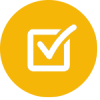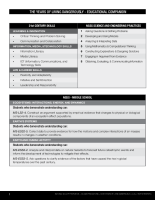
Download the standards tables for Middle School Lesson 3: 21st-Century Skills and NGSS, CCSS, and NCSS.
You can also read the different standards applicable to Middle School Lesson 3 here.
21st Century Skills
Learning & Innovation
- Critical Thinking and Problem Solving
- Communication and Collaboration
Information, Media, &Technology Skills
- Information Literacy
- Media Literacy
- ICT (Information, Communications, and Technology Skills
Life & Career Skills
- Flexibility and Adaptability
- Initiative and Self-Direction
- Leadership and Responsibility
NGSS Science and Engineering Practices
- Asking Questions & Defining Problems
- Developing and Using Models
- Analyzing & Interpreting Data
- Using Mathematics & Computational Thinking
- Constructing Explanations & Designing Solutions
- Engaging in Argument from Evidence
- Obtaining, Evaluating, & Communicating Information
NGSS – Middle School
Ecosystems: Interactions. Energy, and Dynamics
Students who demonstrate understanding can:
MS-LS2-4. Construct an argument supported by empirical evidence that changes to physical or biological components of an ecosystem affect populations.
Earth’s Systems
Students who demonstrate understanding can:
MS-ESS2-5. Collect data to provide evidence for how the motions and complex interactions of air masses results in changes in weather conditions.
Earth and Human Activity
Students who demonstrate understanding can:
MS-ESS3-2. Analyze and interpret data on natural hazards to forecast future catastrophic events and inform the development of technologies to mitigate their effects.
MS-ESS3-5. Ask questions to clarify evidence of the factors that have caused the rise in global temperatures over the past century.
CCSS – ELA —Middle School
Craft and Structure
RST.6-8.4 Determine the meaning of symbols, key terms, and other domain- specific words and phrases as they are used in a specific scientific or technical context relevant to grades 6–8 texts and topics.
Integration of Knowledge and Ideas
RST.6-8.7 Integrate quantitative or technical information expressed in words in a text with a version of that information expressed visually (e.g., in a flowchart, diagram, model, graph, or table).
RST.6-8.8 Distinguish among facts, reasoned judgment based on research findings, and speculation in a text.
RST.6-8.9 Compare and contrast the information gained from experiments, simulations, video, or multimedia sources with that gained from reading a text on the same topic.
Text Types and Purposes
WHST.6-8.1 Write arguments focused on discipline content.
WHST.6-8.2 Write informative/explanatory texts, including the narration of historical events, scientific procedures/ experiments, or technical processes.
Production and Distribution
WHST.6-8.4 Produce clear and coherent writing in which the development, organization, and style are appropriate to task, purpose, and audience.
Research to Build and Present Knowledge
WHST.6-8.9 Draw evidence from literary or informational texts to support analysis, reflection, and research.
Range of Writing
WHST.6-8.10 Write routinely over extended time frames (time for reflection and revision) and shorter time frames (a single sitting or a day or two) for a range of discipline- specific tasks, purposes, and audiences.
RH.6-8.7 Integrate visual information (e.g., in charts, graphs, photographs, videos, or maps) with other information in print and digital texts.
NCSS – Middle School
Culture
Learners will understand:
- How culture influences the ways in which human groups solve the problems of daily living;
- That culture may change in response to changing needs, concerns, social, political, and geographic conditions.
Learners will be able to:
- Evaluate how data and experiences may be interpreted differently by people from diverse cultural perspectives and frames of reference;
- Draw inferences from data about the ways in which given cultures respond to persistent human issues, and how culture influences those responses.
Time, Continuity, and Change
Processes – Learners will be able to:
- Use methods of historical inquiry to make informed decisions as responsible citizens to propose policies and take action on an issue of importance today.
People, Places, & Environments
Learners will understand:
- The theme of people, places, and environments involves the study of the relationships between human populations in different locations and geographic phenomena such as climate, vegetation, and natural resources;
- Past and present changes in physical systems, such as seasons, climate, and weather, and the water cycle, in both national and global contexts;
- Human modifications of the environment;
- Factors that contribute to cooperation and conflict among peoples of the nation and world; including language, religion, and political beliefs;
- The use of a variety of maps, globes, graphic representations, and geospatial technologies to help investigate the relationships among people, places and environments.
Learners will be able to:
- Acquire, organize, and analyze information and use geographic tools to draw conclusions about historic or current national and global environmental change;
- Evaluate the consequences of human actions in environmental terms.
Individuals, Development and Identity
Learners will understand:
- How personal, social, cultural, and environmental factors contribute to the development and the growth of personal identity.
Learners will be able to:
- Examine the impact of conformity and altruism on identity;
- Identify the relationships between individual qualities and career or professional choices.
Individuals, Groups, and Institutions
Learners will understand:
- That groups and institutions change over time;
- That when two or more groups with differing norms and beliefs interact, accommodation or conflict may result;
- That groups and institutions influence culture in a variety of ways.
Power, Authority & Governance
Learners will be able to:
- Analyze and evaluate conditions, actions, and motivations that contribute to conflict and cooperation among groups and nations.
Production, Distribution, & Consumption
Learners will understand:
- The economic choices people make have both present and future consequences.
Science, Technology, and Society
Learners will understand:
- Society often turns to science and technology to solve problems;
- Our lives today are media and technology dependent;
- Science and technology have had both positive and negative impacts upon individuals, societies, and the environment in the past and present;
- Science and technology have changed peoples’ perceptions of the social and natural world, as well as their relationship to the land, economy and trade, their concept of security, and their major daily activities;
- Values, beliefs, and attitudes that have been influenced by new scientific and technological knowledge;
- Science and technology sometimes create ethical issues that test our standards and values.
Learners will be able to:
- Ask and find answer to questions about the ways in which science and technology affect peoples’ lives today in different places, and have done so in the past;
- Select, organize, evaluate, and communicate information about the impact of science or technology on a society today or in the past;
- Use scientific findings and forms of technology to formulate possible solutions to real-life issues and problems, and predict outcomes.
Global Connections
Learners will understand:
- Spatial relationships that relate to ongoing global issues (e.g. pollution, poverty, disease, and conflict) affect the health and well-being of Earth and its inhabitants;
- Global problems and possibilities are not generally caused or developed by any one nation;
Learners will be able to:
- Analyze examples of conflict, cooperation, and interdependence among groups, communities, regions, societies, and nations;
- Explore the causes, consequences, and possible solutions related to persistent, current, and emerging global issues, such as health, resource allocation, economic development, and environmental quality.
Civic Ideals and Practices
Learners will understand:
- The theme of civic ideals and practices helps us to learn about and know how to work for the betterment of society;
- Key past and present issues involving democratic ideals and practices, as well as the perspectives of various stakeholders in proposing solutions to these issues;
- The importance of becoming informed in order to make positive civic contributions.
Learners will be able to:
- Ask and find answers to questions about how to become informed and take civic action;
- Identify, seek, describe, and evaluate multiple points of view about selected issues, noting strengths, weaknesses, and consequences associated with holding each position;
- Develop a position on a public policy issue, and defend it with evidence.


